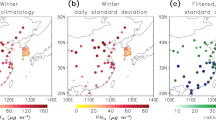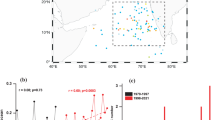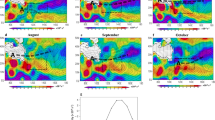Abstract
Throughout the year, average sea surface temperatures in the Arabian Sea are warm enough to support the development of tropical cyclones1, but the atmospheric monsoon circulation and associated strong vertical wind shear limits cyclone development and intensification, only permitting a pre-monsoon and post-monsoon period for cyclogenesis1,2,3,4. Thus a recent increase in the intensity of tropical cyclones over the northern Indian Ocean5 is thought to be related to the weakening of the climatological vertical wind shear3,4. At the same time, anthropogenic emissions of aerosols have increased sixfold since the 1930s, leading to a weakening of the southwesterly lower-level and easterly upper-level winds that define the monsoonal circulation over the Arabian Sea6,7,8,9. In principle, this aerosol-driven circulation modification could affect tropical cyclone intensity over the Arabian Sea, but so far no such linkage has been shown. Here we report an increase in the intensity of pre-monsoon Arabian Sea tropical cyclones during the period 1979–2010, and show that this change in storm strength is a consequence of a simultaneous upward trend in anthropogenic black carbon and sulphate emissions. We use a combination of observational, reanalysis and model data to demonstrate that the anomalous circulation, which is radiatively forced by these anthropogenic aerosols, reduces the basin-wide vertical wind shear, creating an environment more favourable for tropical cyclone intensification. Because most Arabian Sea tropical cyclones make landfall1, our results suggest an additional impact on human health from regional air pollution.
This is a preview of subscription content, access via your institution
Access options
Subscribe to this journal
Receive 51 print issues and online access
$199.00 per year
only $3.90 per issue
Buy this article
- Purchase on Springer Link
- Instant access to full article PDF
Prices may be subject to local taxes which are calculated during checkout



Similar content being viewed by others
References
Evan, A. T. & Camargo, S. J. A climatology of Arabian Sea cyclonic storms. J. Clim. 24, 140–158 (2011)
Gray, W. M. Global view of the origin of tropical disturbances and storms. Mon. Weath. Rev. 96, 669–700 (1968)
Krishna, K. M. Intensifying tropical cyclones over the North Indian Ocean during summer monsoon—global warming. Global Planet. Change 65, 1–2,–12–16 (2009)
Rao, V. B., Ferreira, C. C., Franchito, S. H. & Ramakrishna, S. S. V. S. In a changing climate weakening tropical easterly jet induces more violent tropical storms over the north Indian Ocean. Geophys. Res. Lett. 35, L15710 (2008)
Singh, O. P., Kahn, A. & Rahman, S. Has the frequency of intense tropical cyclones increased in the North Indian Ocean? Curr. Sci. 80, 575–580 (2001)
Dash, S. K., Kulkarni, M. A., Mohanty, U. C. & Prasad, K. Changes in the characteristics of rain events in India. J. Geophys. Res. 114, D10109 (2009)
Chung, C. E. & Ramanathan, V. Weakening of North Indian SST gradients and the monsoon rainfall in India and the Sahel. J. Clim. 19, 2036–2045 (2006)
Meehl, G., Arblaster, J. & Collins, W. Effects of black carbon aerosols on the Indian monsoon. J. Clim. 21, 2869–2882 (2008)
Ramanathan, V. et al. Atmospheric brown clouds: impacts on South Asian climate and hydrological cycle. Proc. Natl Acad. Sci. USA 102, 5326–5333 (2005)
Ramanathan, V. et al. The Indian Ocean experiment: an integrated assessment of the climate forcing and effects of the great Indo-Asian haze. J. Geophys. Res. 106, 28371–28398 (2001)
Wang, C., Kim, D., Ekman, A. M. L., Barth, M. C. & Rasch, P. J. Impact of anthropogenic aerosols on Indian summer monsoon. Geophys. Res. Lett. 36, L21704 (2009)
Chung, C. E., Ramanathan, V., Kim, D. & Podgorny, I. Global anthropogenic aerosol direct forcing derived from satellite and ground-based observations. J. Geophys. Res. 110, D24207 (2005)
Emanuel, K. Tropical cyclones. Annu. Rev. Earth Planet. Sci. 31, 75–104 (2003)
DeMaria, M. & Kaplan, J. An updated statistical hurricane intensity prediction scheme (SHIPS) for the Atlantic and eastern North Pacific basins. Weather Forecast. 14, 326–337 (1999)
Emanuel, K. A. The maximum intensity of hurricanes. J. Atmos. Sci. 45, 1143–1155 (1988)
Elsner, J. B., Kossin, J. P. & Jagger, T. H. The increasing intensity of the strongest tropical cyclones. Nature 455, 92–95 (2008)
Knapp, K. P., Kruk, M. C., Levinson, D. H., Diamond, H. J. & Neumann, C. J. The International Best Track Archive for Climate Stewardship (IBTrACS): unifying tropical cyclone data. Bull. Am. Meteorol. Soc. 91, 363–376 (2010)
Dvorak, V. F. Tropical Cyclone Intensity Analysis using Satellite Data. Technical Report no. 11 (NOAA, 1984)
Kossin, J. P., Knapp, K. R., Vimont, D. J., Murnane, R. J. & Harper, B. A. A globally consistent reanalysis of hurricane variability and trends. Geophys. Res. Lett. 34, L04815 (2007)
Kanamitsu, M. et al. NCEP-DOE AMIP-II reanalysis (R-2). Bull. Am. Meteorol. Soc. 83, 1631–1643 (2002)
Kossin, J. P. & Camargo, S. J. Hurricane track variability and secular potential intensity trends. Clim. Change 97, 329–337 (2009)
Frank, W. M. & Ritchie, E. A. Effects of vertical wind shear on the intensity and structure of numerically simulated hurricanes. Mon. Weath. Rev. 129, 2249–2269 (2001)
Elsberry, R. L. & Jeffries, R. A. Vertical wind shear influences on tropical cyclone formation and intensification during TCM-92 and TCM-93. Mon. Weath. Rev. 124, 1374–1387 (1996)
Kumari, P. B., Londhe, A. L., Daniel, S. & Jadhav, D. B. Observational evidence of solar dimming: offsetting surface warming over India. Geophys. Res. Lett. 34, L21810 (2007)
Rayner, N. A. et al. Global analyses of sea surface temperature, sea ice, and night marine air temperature since the late nineteenth century. J. Geophys. Res. 108, 4407 (2003)
UNEP . Integrated Assessment of Black Carbon and Tropospheric Ozone - Summary for Decision Makers. UNEP/GC/26/INF/20 (United Nations Environment Program and World Meteorological Organization, 2011)
Kiehl, J. T. et al. The National Center for Atmospheric Research Community Climate Model: CCM3. J. Clim. 11, 1131–1149 (1998)
Chung, C. E. & Ramanathan, V. South Asian haze forcing: remote impacts with implications to ENSO and AO. J. Clim. 16, 1791–1806 (2003)
Acknowledgements
Partial funding for this work was provided by National Oceanic & Atmospheric Administration (NOAA)/Climate Program Office (NA10OAR4310136), Korea’s Research Agency for Climate Science (RACS 2010-2603) and the National Science Foundation (ATM-0721142). Data from National Centers for Environmental Prediction reanalyses 1 and 2 were provided by the NOAA/Office of Oceanic and Atmospheric Research/Earth System Research Laboratory Physical Sciences Division, Boulder, Colorado, USA, from their website (http://www.esrl.noaa.gov/psd/).
Author information
Authors and Affiliations
Contributions
A.E. and V.R. conceived the project. A.E. and J.K. designed the study. A.E., J.K. and E.C. provided model and observational data. All authors participated in data interpretation and co-wrote the manuscript.
Corresponding author
Ethics declarations
Competing interests
The authors declare no competing financial interests.
Supplementary information
Supplementary Information
The file contains Supplementary References, Supplementary Figures 1-6 with legends, and Supplementary Tables 1-2. (PDF 2636 kb)
Supplementary Data
This file contains raw data used to make all Figure and Tables in this study. These include: climatological fine mode AOD from MODIS, Arabian Sea TC tracks, maximum intensities, and storm-ambient shear, and SST and vertical shear trends from models and observations/reanalysis. (XLS 1942 kb)
Rights and permissions
About this article
Cite this article
Evan, A., Kossin, J., ‘Eddy’ Chung, C. et al. Arabian Sea tropical cyclones intensified by emissions of black carbon and other aerosols. Nature 479, 94–97 (2011). https://doi.org/10.1038/nature10552
Received:
Accepted:
Published:
Issue Date:
DOI: https://doi.org/10.1038/nature10552
This article is cited by
-
Dynamics of land, ocean, and atmospheric parameters associated with Tauktae cyclone
Environmental Science and Pollution Research (2024)
-
Role of north Indian Ocean on the lightning flash rate of the Indian land region
Theoretical and Applied Climatology (2023)
-
The co-variability of SST and vertical wind shear on the variability of tropical cyclone intensity change in the Northern Hemisphere
Climate Dynamics (2023)
-
Impact of environmental variables on the North Indian Ocean tropical cyclones radial parameters
Climate Dynamics (2023)
-
Impact of Tropical Cyclones over the North Indian Ocean on Weather in China and Related Forecasting Techniques: A Review of Progress
Journal of Meteorological Research (2023)
Comments
By submitting a comment you agree to abide by our Terms and Community Guidelines. If you find something abusive or that does not comply with our terms or guidelines please flag it as inappropriate.



